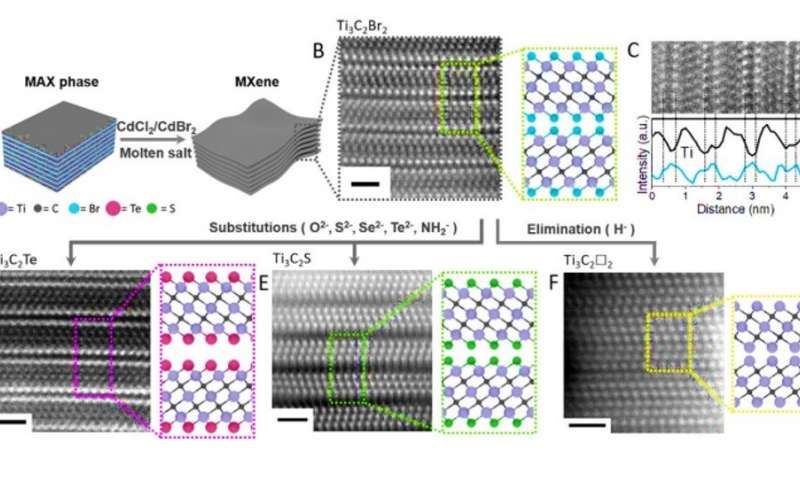HOME
A new strategy to synthesize 2-D inorganic materials used in capacitors, batteries, and composites

Surface reactions of MXenes in molten inorganic salts. (A) Schematics for etching of MAX phases in Lewis acidic molten salts. (B) Atomic resolution high-angle annnular dark-field (HAADF) image of Ti3C2Br2 MXene sheets synthesized by etching Ti3AlC2 MAX phase in CdBr2 molten salt. The electron beam is parallel to 2 1 10 zone axis. (C) Energy dispersive X-ray (EDX) elemental analysis (line scan) of Ti3C2Br2 MXene sheets. HAADF images of (D) Ti3C2Te and (E) Ti3C2S MXenes obtained by substituting Br for Te and S surface groups, respectively. (F) HAADF image of Ti3C2□2 MXene (□ stands for the vacancy) obtained by reactive elimination of Br surface groups. All scale bars are 1 nm. Credit: Science Advances, doi: 10.1126/science.aba8311
Surface functional groups in two dimensional (2-D) transition-metal carbides can undergo versatile chemical transformations to facilitate a broad class of MXene materials. In a new report on Science, Vladislav Kamysbayev, and a team of scientists in chemistry, physics and nanoscale materials at the James Franck Institute, the University of Chicago and the Argonne National Laboratory in the U.S. introduced a general strategy to synthesize MXenes. Using the method, they installed and removed surface groups via substitution and elimination reactions within molten inorganic salts. The team successfully synthesized MXenes with oxygen (O), imidogen (NH), sulfur (S), chlorine (Cl), selenium (Se), bromide (Br) and tellurium (Te) surface terminations. They also designed and developed bare MXenes without surface terminations and with distinctive structures and electronic properties. The surface groups could also control the interatomic distances in the MXene lattice to exhibit surface group-dependent superconductivity.
Scientists have studied MXenes for applications in supercapacitors, batteries, electromagnetic interference shielding and composites. The substrates can be typically synthesized from corresponding MAX phases where M stands for the transition metal, X stands for carbon or nitrogen, by selectively etching the main group element A, which can include aluminum (Al), gallium (Ga), silicon (Si) and other elements. Researchers typically perform etching in aqueous hydrogen fluoride (HF) solutions that render MXenes with a mixture of fluoride (F), oxygen (O) and hydroxide (OH) functional groups, commonly denoted as Tx. The functional groups can also be chemically modified, unlike the surfaces of other 2-D materials such as graphene and transition dichalcogenides. Previous research had shown that selective terminations of MXenes with different surface groups can lead to remarkable properties, including tunable work functions and 2-D ferromagnetism. Covalent functionalization of the substrate will lead to uncover new directions to rationally engineer 2-D functional materials.
By etching MAX phases in molten salts in the lab, the scientists eliminated undesired oxidation and hydrolysis reactions to synthesize the new MXenes. Kamysbayev et al. characterized the samples using high-resolution scanning transmission electron microscopy (STEM), Raman spectroscopy and a combination of X-ray methods. They showed how chloride (Cl-) and bromide (Br-) terminated MXenes could efficiently engage in new types of surface reactions. The process allowed unprecedented control across the surface chemistry, structure and properties of MXene materials. Chloride and bromide-based MXenes with labile (easy to alter) surface bonding acted as versatile synthons for additional chemical transformations. The MXene surface exchange reactions required temperatures of 300 degrees Celsius to 600 degrees Celsius, which are difficult to achieve through traditional solvents. The team therefore used molten alkali metal halides in solvents with unmatched high-temperature stability and high solubility. For example, halogenated MXenes such as Ti3C2Br2 dispersed in alkali halides such as caesium bromide, potassium bromide or lithium bromide (CsBr/KBr/LiBr) could react with dilithium telluride (Li2Te) and lithium sulfide (Li2S) to form MXenes with a telluride or sulfide-based group.
News Source